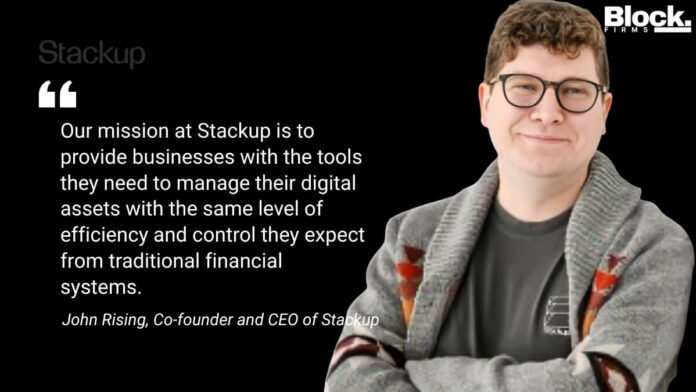Stackup, a digital asset management platform simplifying crypto operations for businesses, has raised $4.2 million in seed funding. The round was led by 1kx and attracted participation from top VCs, including Y Combinator, Goodwater Capital, Soma Capital, Amino Capital, and Digital Currency Group (DCG).
The funding coincides with the launch of Stackup’s direct banking integration, a feature that allows businesses to link traditional bank accounts directly to their Stackup wallets. The move enables non-custodial ACH transfers between fiat and crypto systems, addressing a long-standing issue: the friction between legacy financial rails and decentralized asset management.
“Our mission at Stackup is to provide businesses with the tools they need to manage their digital assets with the same level of efficiency and control they expect from traditional financial systems,” said Stackup CEO and Co-founder John Rising.
“We’re empowering businesses to streamline their financial operations and workflows, allowing them to focus on growth without compromising on security or control of their assets,” he added.
Why This Matters?
For crypto-native businesses and Web3 startups, fragmented operations between banks and on-chain platforms have historically created inefficiencies in treasury, compliance, and accounting workflows. As the institutional market grows—digital asset investment products now exceed $100 billion in AUM according to CoinShares—the demand for enterprise-grade tools that mirror the simplicity of traditional finance is surging.
A 2023 Deloitte survey revealed that 73% of executives at financial institutions believe digital assets will become mainstream within the next 10 years, yet cite “lack of integration with existing systems” as a primary barrier to adoption.
Stackup’s solution—particularly its support for Ethereum, Base, Arbitrum, Optimism, Polygon, Avalanche, and BSC—gives businesses operating across multiple chains a unified dashboard to manage transactions, liquidity, and security without bridging assets manually or maintaining multiple wallets.
Bringing Order to Multi-Chain Chaos
Previously, crypto enterprises juggling multiple chains had to rely on third-party bridges, increasing their attack surface and operational complexity. Stackup’s infrastructure abstracts this complexity by allowing seamless movement of assets across supported chains—without compromising on self-custody.
This capability is vital as multi-chain adoption rises. A report by Messari highlights that over 70% of DeFi protocols now operate across more than one blockchain, further validating the need for a streamlined multi-chain asset management system.
Stackup Has Played Key Role in Coinbase and TrustWallet
Stackup’s credibility is rooted in its foundational role building wallet infrastructure for Coinbase and TrustWallet—two of the industry’s most trusted platforms. That enterprise-grade experience has been channeled into building an all-in-one system aimed at scaling crypto businesses without sacrificing control.
“Crypto businesses have largely struggled to address their operational needs due to the unique burden of managing assets on multiple chains,” said Nichanan Kesonpat of 1kx. “Stackup is addressing those critical pain points and enabling businesses to take control of their funds in one seamless, secure, and scalable platform.”
As Web3 moves from early experimentation to enterprise adoption, the companies that survive will be those that can scale across both financial realms. With fresh capital, growing institutional support, and product-market fit in a rapidly expanding segment, Stackup is likely to lead the charge.
Read Also: How Great Crypto Startup Founders Build And Win in Web3




